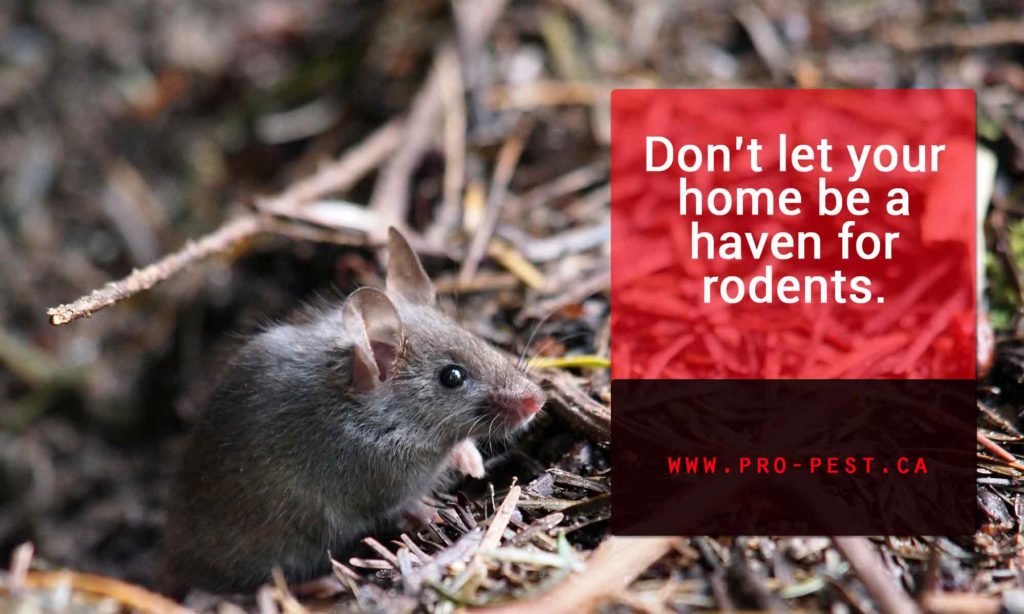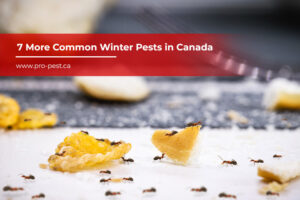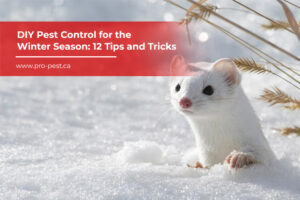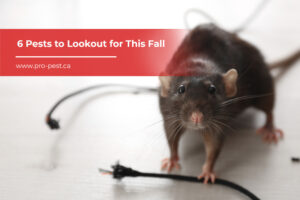As Canadians retreat indoors from the winter weather, they may be unknowingly inviting furry intruders into their homes. These rodents do not hibernate — and when food, water, and shelter are scarce, they’ll go looking for it. One of the first places they’ll look may be your home. Luckily, there are many ways to prevent this problem.
Mice pose a threat to the very structure of your home, as well as your clothes, furnishings, and food storage. They present a significant health risk as well, since mouse urine, waste, saliva, and nest materials can hold bacteria and disease. The more mice you have in your home, the greater the risk. There is also an increased risk of fire as a result of a mouse presence, since they can chew on electrical wires. Mice can also chew electrical car wiring, which might present a danger if vehicles are stored inside a garage.

When a homeowner spots a mouse, it’s likely that the problem is even bigger than first realized. The common house mouse (Mus musculus) weighs approximately one ounce, with a length of two inches. This means they can squeeze into incredibly small spaces, hiding in walls, attics, and under floorboards. Whether you’re trying to avoid future infestations or managing one that’s already been spotted, the first step is to understand how rodents can get into your home.
How Mice Get In
Rodents are remarkably inventive when seeking entry points.
- Holes and Cracks
These can occur beside windows and doors and in floorboards or walls. As building materials shift and ice forms, cracks appear as a result of dropping temperatures. (A young mouse can squeeze through a space the width of a pencil.) - Pipes
While mice can crawl in through the pipes themselves, a common entry point is via the space around the pipes. Since piping is often concealed within a wall, improperly fitted pipes can be difficult to spot. - Doors
If doors and windows aren’t carefully sealed and fitted to a frame, mice can squeeze in through these openings. Garage doors can be particularly problematic. - Drains
Basement drains are often difficult to secure, and pipes create a runway to and from the exterior. Loose-fitting drain covers can shift and crack in winter weather, providing mice with an accessible water source as well as an entryway.

- Foundation
Cracks in the foundation of a home need not be large in order to create an entry point. - Vents
Dryer and attic vents provide mice with quick and easy access routes.
Why Reducing Clutter Can Help
Fewer hiding spots: Wood piles, in particular, provide a safe haven for rodents. Raising wood piles at least one foot off the ground can help prevent this.
Increased visibility: Removing debris from window ledges and around baseboards will help to spot weather-related cracks that could allow access. Organizing exterior clutter and garbage bins also makes it easier to detect any damage to your foundation.

Limited food sources: A cluttered kitchen means crumbs. Food items left on counters and shelves are particularly appealing to mice, and improperly sealed cupboards and containers make access to food easy. In addition, dirty plates and food containers left elsewhere in your home make a hungry mouse very happy (as do any uncovered or displaced refuse bins).

Decreased nesting opportunities: Trash and discarded debris around your home and garage provide mice with all the essentials to create a comfortable nest. Removing it reduces the likelihood of nests forming.
Easier access for cleaning: Keeping your home clean reduces the availability of nesting materials, food, and potential nest areas. Decluttering helps you clean quickly and more easily.
Fewer nesting materials: Mice use a wide variety of materials to make their nests: old papers, textiles, cardboard boxes, string, mattress material, and fiberglass insulation. Reducing access to these items and removing old, discarded materials from your home makes your living space less attractive to shelter-seeking pests.

Secure drainage: When the covers of floor drains are dislodged or damaged, pipes provide a quick way in. Piled-up boxes and belongings can dislodge or crack the screens of these drains, removing any barriers for rodents. Seal up cracks and holes immediately and remove clutter to allow for increased visibility of any further issues.
Attics and Basements
Attics, basements (and other storage spaces) naturally collect more clutter, making it harder to spot signs of an infestation. Low lighting in these areas can result in undetected warning signs or potential entry points. Additionally, old furniture items provide mice with prime nesting materials. In the unfortunate event of an infestation, reducing clutter will help you spot the problem before it spins out of control.
Signs of an Infestation
Knowing what to look for means you can take action sooner.
- Droppings
Droppings will be concentrated in feeding areas or near nests, and are often found in cupboards, drawers, and under sinks. Droppings will be scattered randomly in groups, and are about 3-8 millimetres in length. - Noise
Mice can be very noisy! They are nocturnal, so most noises are detectable after dark. This includes scratching, gnawing, and running, both out in the open and inside your walls. If you hear any of these noises during the day, it likely indicates a larger infestation. - Sightings
Sightings are a clear indication of an infestation. While you may spot mice during the day, the likelihood increases at night when they are naturally more active. - Small holes in boxes or bags
This indicates that mice are trying to access a food source or collecting nesting materials. Mice have powerful teeth; they can nibble through thick cardboard, even wood. - Damage to furniture
Mice will remove filling from mattresses, tear holes in pillows, chew carpets, and burrow into any piece of stuffed furniture. Repeated gnawing can destroy expensive wooden furniture. - Missing or damaged food
This is often one of the first signs of a mouse’s presence. Mice can make quite a mess of kitchen cupboards and drawers, and they will wiggle into any unsealed container. Mice will eat almost anything and will return to a reliable food source up to 30 times a night. - Foul odour
Depending on the scale and timeline of an infestation, you may notice a foul odour. This could emanate from a wall or from behind cupboards or appliances. It may be accompanied by an increase in houseflies and will worsen come spring as temperatures start to rise. A common culprit is a dead mouse, and one corpse means that you’re likely to find others. Removal and disposal of dead animals poses a heightened risk of disease and should be handled by a pest control professional.
Sometimes it can be difficult to determine which type of rodent has invaded your home. If you see a nest larger than 6 inches—particularly in a basement or crawlspace—you may have rats. Rats have a lengthy list of health risks associated with them and their burrowing can threaten the stability of your home. If you suspect a rat infestation, be sure to contact an experienced rat removal expert.
Reducing clutter helps prevent infestation and makes dealing with one easier. Once your home is mouse-free, there are several tools you can take to keep it that way:
- Steel wool: Use this in the spaces around pipes.
- Wire mesh: This can be used to plug up any larger holes, such as vents.
- Weather-stripping: Install this around doors, focusing on the bottom first.
- Reduction/removal of waste: Take garbage out nightly to keep it from piling up.
- Food storage: Food should be kept in sealed glass jars or containers.
A professional pest removal company can provide more detailed advice regarding how to secure your home throughout the winter and beyond.
At Pro-Pest, we provide expert, high-quality pest control services in Toronto. If you suspect an animal infestation or have any immediate questions or concerns—day or night—call us at (416) 487-4179.



















